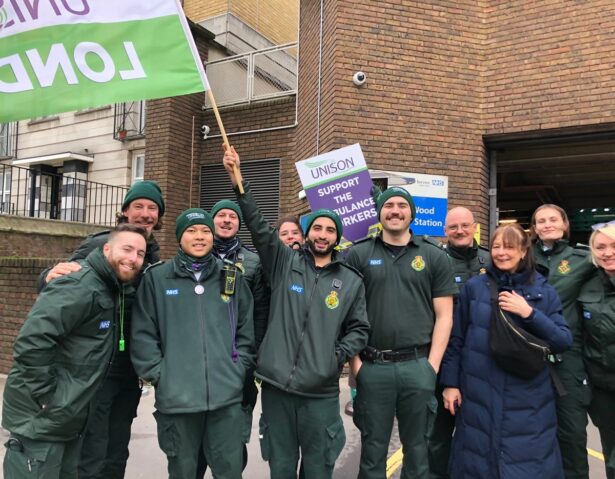For the first time in the 75-year history of the U.K.’s National Health Service, nurses and ambulance workers held strikes on Feb. 7 — and members of the Royal College of Nursing, the nation’s largest nursing union, went on its first ever walk-out. Tens of thousands of nurses went on strike and picketed in favor of an increase in wages, which are 10 percent less today in real terms than in 2011.
Every ambulance service in the U.K. has also had an active strike mandate as of Feb. 8, according to the general trade union GMB.
“We’re trying to keep maximum pressure on the government, but also have to pace ourselves a little bit so it’s not too much pressure on the members in terms of the amount of money they’re losing, and also pressure on the service,” said Jamie Brown, regional manager and head of health for London Ambulance Service branch of Unison, the U.K.’s largest ambulance workers’ union.
Brown’s branch has recruited about 800 new members in the last six weeks and a higher percentage of workers have turned out on each successive strike date. At first, they began with road crews only but expanded to include emergency call handlers, education teams and non-urgent call handlers.
Physiotherapists also held their first ever strikes last month, with 4,200 workers in 33 medical districts walking out.
While government and many larger media outlets frame the issue as a pay debate, health workers are calling for safe staffing levels and improved provision of patient care. But better pay is the means to correct the crisis in staffing.
“Yes, there’s hospital beds, there’s ambulances, but if you don’t have people to drive them or to attend to patients then you can’t deliver the care that people should expect from the NHS.”
“The pay is really the main thing, because it’s the incentive for retention and new recruitment,” explained a dermatology nurse protesting outside St. Thomas’ Hospital in London during her scheduled clinic shift. According to the 20-year veteran of the National Health Service, or NHS, who cares for patients with severe skin diseases and cancers, caseloads for nurses are more than double the normal amount and many nurses died during the pandemic. “If they’re stressed and exhausted, then that takes a toll on their mental health and performance,” she added.
More people are staying longer in hospitals with 94 percent of beds in the country occupied in the last week of January, and ambulance response times continue to rise, according to the NHS.
“The way that the service is run at the moment, they can’t provide the care that they were employed to provide, and therefore they can’t do their jobs,” Brown said. “So it’s as much about protecting the service and sounding an alarm to the general public that there’s a crisis in the service, which is largely a staffing crisis.”
There are currently 145,000 job vacancies across the NHS, and 25,000 nurses left just last year. Aside from attrition, the service has also struggled to recruit new employees. This is borne out by new figures showing a 19 percent decrease in applications to nursing school over the past two years.
Despite the pandemic inspiring many people to become health care workers, they’ll need a minimum of three years of education, which current nurses don’t feel is reflected in their pay.
“If you didn’t have a workforce there wouldn’t be a service,” Brown said. “Yes, there’s hospital beds, there’s ambulances, but if you don’t have people to drive them or to attend to patients then you can’t deliver the care that people should expect from the NHS.”

Support Us
Waging Nonviolence depends on reader support. Become a sustaining monthly donor today!
DonateWhile care has suffered, so have the workers, both through mental and physical exhaustion on the job and from increasing financial insecurity with inflation currently over 10 percent in the U.K.
Burnout in the ambulance corps is constant, and workers fear for their immediate financial needs and future prospects, according to Jess, a paramedic in Waterloo, London who declined to give her full name. “That’s a very scary feeling not knowing where your next meal is going to come from,” she said. “Having been there myself, it’s just a terrifying experience.”
Still, she always wanted to serve on an ambulance team and couldn’t imagine doing anything else, but she said she never expected to have to turn to collective action.
Although she’s only been on the team for four and a half years, she says the extraordinary turnover rates have made her a senior team member. “It shouldn’t be like that. I shouldn’t be seen as one of the more experienced members because I’m not; I haven’t been out there for long enough.”
For the 2022-2023 fiscal year, the government offered a pay raise of 4 percent for the NHS, but organizers consider it an effective pay cut in light of current inflation.
The Royal College of Nursing, or RCN, initially wanted 5 percent above inflation but has since said it would accept an offer of 7 percent, which would still amount to a 3 percent cut in real terms.
But the government has so far refused to even discuss the current year’s pay with unions.
A recent letter by the RCN General Secretary Pat Cullen concerning the care and staffing crisis received no answer at all from Prime Minister Rishi Sunak, prompting her to retort that perhaps the government itself is on strike.
Therefore, the current situation is at a standstill, with the government waiting for what organizers described as a miracle in the economy and various unions voting on additional strike actions.
In the meantime, the government issued recommendations that citizens not engage in potentially dangerous activities on strike days.
A growing threat to the right to strike
The government has proposed new legislation that would make it harder to strike by setting “minimum safety levels” for workers in essential services like ambulances, firefighters and some transportation workers. The January 2023 bill had its roots in the Conservative Party’s 2019 election manifesto, but has expanded its initial focus on transportation to other sectors.

Organizers consider it ironic and insulting that the government wants to mandate minimum staffing on strike days when low staffing on normal days is a main reason they are striking in the first place. And they certainly consider this move a threat to their ability to protest.
“If they get it their own way, it will be horrendous for us because we won’t be allowed to do anything,” said Eddie Brand, a 37-year EMT veteran and trade union representative for 25 years, now Unison branch secretary at the London Ambulance Service. “This government is finished. I’ve never seen such hatred toward a government.”
Brown also made the case that the bill would effectively destroy the right to strike, since it seeks to prevent any disruption to entire essential sectors. It also sets no standard for dispute resolution between unions and governments and allows ministers to determine who the concerned parties are for conversations.
The existing strike legislation in the country is already very strict, particularly when it comes to coordinated action. “Both the general strike but also secondary picketing was banned by Margaret Thatcher in the 80s, so it’s very difficult to coordinate unions to take strike action,” Brown explained.
Different departments must also share the work that remains while workers strike.
“We’re trying our best not to put people at risk, but we’ve got no choice. We’ve got to stand up for ourselves at the end of the day and fight back against this government.”
According to Brown, responders at the Waterloo branch of London Ambulance Service had to cancel their participation in strikes planned for Feb. 22 because they’ll have to balance out the workload of departments striking in other parts of the country.
Departments in different locations also have different caseloads, so the minimum service that needs to be maintained during industrial action must be negotiated locally.
All of this complicates industrial action and especially the prospects for cooperation across units and industries.
Unison members have arranged for a strike fund to pay striking workers at a rate of 50 pounds per day. That’s far less than they would make during a full day’s work, “but it will ease the burden,” Brown said.
So far, ambulance workers are only going out for half of their scheduled shifts on strike days.
“As it goes on it’s tricky cause not everyone can afford to strike, and that’s completely fair,” Jess said. “I feel like those of us who are standing on the picket line, we’re standing for everyone, whether they want to strike or can strike, and that’s definitely the mentality that I feel from pretty much everyone.”
Government miscalculation
Previous disputes like the ones over NHS pensions didn’t resonate as much with the public because they seemed remote, Brown said. But the current strike over preserving the popular NHS and fairly rewarding those who helped save lives throughout the pandemic is garnering more sympathy.
Brown said the government has accused the ambulance services of not providing “life and limb cover” during strikes, meaning that it is not responding to the most extreme calls where lives are at immediate risk.
“[That] is an utter, total lie, because basically the leaders of this ambulance service branch have negotiated with the employer very, very strict life and limb cover,” Brown said.
“They don’t wanna put people at risk,” Brand said. “We’re trying our best not to put people at risk, but we’ve got no choice. We’ve got to stand up for ourselves at the end of the day and fight back against this government.”
At the moment, ambulance departments are waiting for other groups that very narrowly missed the 50 percent legal threshold for strike action to vote again.
Brown explained that it’s better for the departments to wait for others to ballot so they can strike together on the same day, which is now planned for March 8. With strikes becoming more frequent the longer the government withholds an offer, strikes by different groups will be more likely to coincide. Junior doctors, for instance, are also balloting now.
He predicts the dispute will continue to escalate, since the unions are demanding an acceptable pay raise by April 1 for both this year and 2024.
Alongside continued balloting, Unison will continue encouraging members and citizens to write letters to their government and keep turning up the pressure. Brown thinks the government miscalculated, hoping the public would turn on — or slowly forget about — the striking workers, but he feels support remains high in the country.
For Brand, the best hope may be for an eventual general election to discard the proposed strike law and enact necessary pay raises.
Workers are also thinking long term. “It’s really about the future and the youth,” said Abdul Faruk, a manager in ambulance maintenance services striking alongside paramedics. While noting that he was fortunate to be more established, Faruk is still worried for the future of the service. “My daughter is training to become a midwife. She wants to help in that way. But I’m not sure she’s made the right choice.”
Outside of St. Thomas’ Hospital a striking nurse named Mark said, “It’s given me hope for the profession, standing up for ourselves for the first time.”

Excellent article, clear and easy to follow. Thank you for explaining the situation so a lay person has understanding, as we should all be concerned with our healthcare system and the service/care they are equipped and able to provide.
As an RN in the US…our needs for staff staffing parallel with the UK